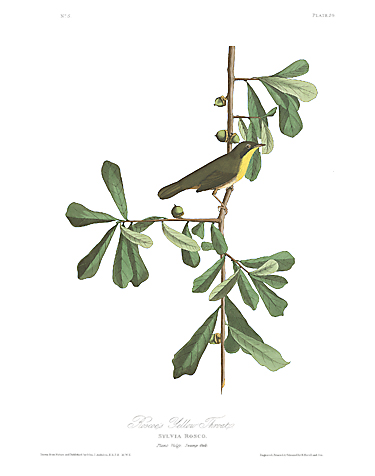|
Havell Name
Roscoe's Yellow Throat Common Name Common Yellowthroat Havell Plate No. 024 Paper Size 39" x 28" Image Size 14" x 10" Price $ 600 |
||||
|
Ornithological Biography The notes of this little bird render it more conspicuous than most of its genus, for although they cannot be called very musical, they are far from being unpleasant, and are uttered so frequently during the day, that one, in walking along the briary ranges of the fences, is almost necessarily brought to listen to its whitititee, repeated three or four times every five or six minutes, the bird seldom stopping expressly to perform its music, but merely uttering the notes after it has picked an insect from amongst the leaves of the low bushes which it usually inhabits. It then hops a step or two up or down, and begins again.
Although timid, it seldom flies far off at the approach of man, but instantly dives into the thickest parts of its favourite bushes and high grass, where it continues searching for food either along the twigs, or among the dried leaves on the ground, and renews its little song when only a few feet distant. Its nest is one of those which the Cow Bunting, Molothrus (Icterus) pecoris, selects, in which to deposit one of its eggs, to be hatched by the owners, that bird being similar in this respect to the European Cuckoo. The nest, which is placed on the ground, and partly sunk in it, is now and then covered over in the form of an oven, from which circumstance children name this warbler the Oven-bird. It is composed externally of withered leaves and grass, and is lined with hair. The eggs are from four to six, of a white colour, speckled with light brown, and are deposited about the middle of May. Sometimes two broods are reared in a season. I have never observed the egg of the Cow Bunting in the nests of the second brood. It is less active in its motions than most birds of the genus, but makes up this deficiency by continued application, it being, to appearance, busily employed during the whole of the day. It does not chase insects by flying after them, but secures them by surprise. Caterpillars and spiders form its principal food. Although this species is found throughout the Union, the Middle States seem to attract and detain more individuals, during the breeding season, than any others. Very few breed in Louisiana. In Kentucky, however, many breed in the barrens. The neighbourhood of swamps and such places is their favourite ground, but every field provided with briar patches or tall weeds harbours some of them. It leaves the Central Districts about the middle of September. The male bird does not attain its full colouring until the first spring, being for several months of the same tints as the female. The twig on which the males are seen, is commonly called in Louisiana the wild olive. The tree is small, brittle and useless. It bears an acid fruit, which is sometimes employed as a pickle, and eaten when ripe by some people. |
|||||
|
|
|||||


| Home | Gallery | Audubon Biography | About Edition | Testimonials | Authorized Dealers | Links | Contact Us |

© Copyright 2007-2025 Zebra Publishing, LLC. | All Rights Reserved Terms of Use
Powered by Fusedog Media Group
